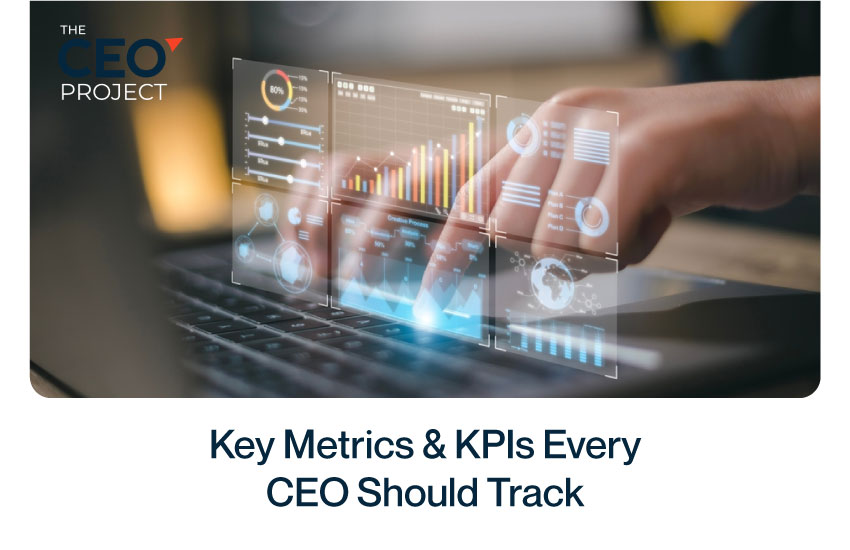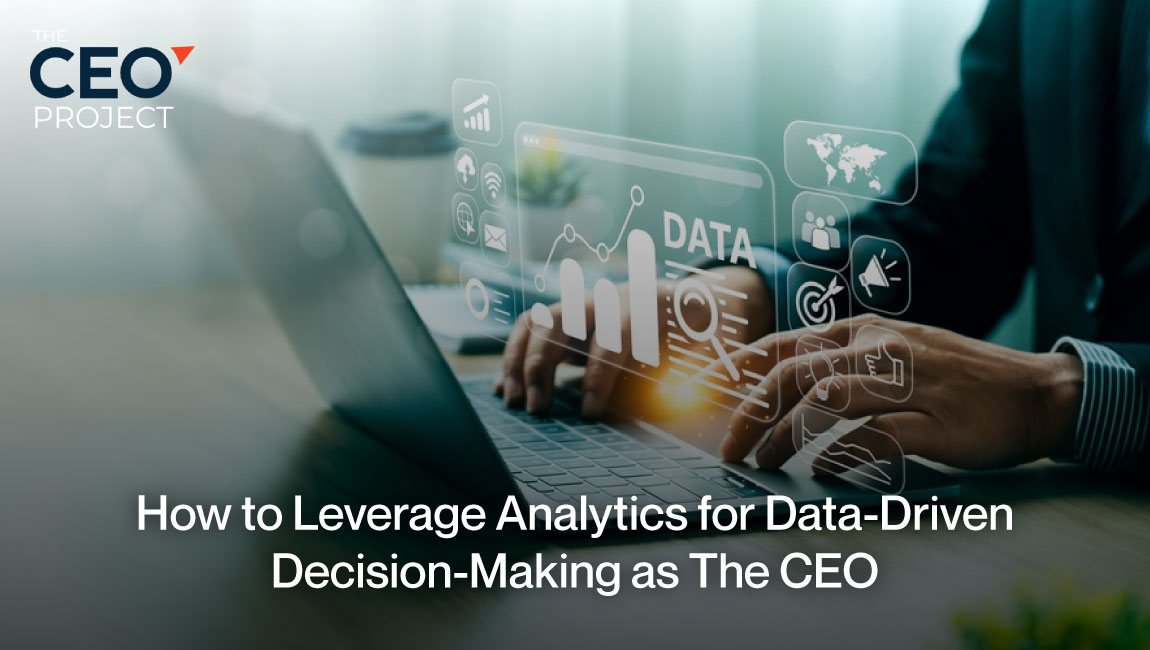With the rapid development of the business world, making data-driven decision-making to ensure the viability of the business has become essential. CEOs are the ultimate decision-makers in their organizations, ensuring that firms perform optimally. However, in a world of saturated data, the real challenge is not collecting data but interpreting it and utilizing it to fuel growth.
According to McKinsey, proper data-driven firms are five times more likely to make faster decisions and three times more likely to have improved decision-making capabilities. However, only 23% of CEOs consistently use data-driven insights in decision-making (PWC). So, how do you, as a CEO, join this elite group and use analytics to create more thoughtful and more impactful decisions?
In this article, we’ll discuss the basic strategies for applying analytics, from interpreting various data analytics to utilizing them in your company’s decision-making process. By the end of this article, you’ll gain actionable insights on how you can start leveraging data to your benefit.

Why CEOs Need to Prioritize Data-Driven Decision-Making
As the Chief Executive Officer, you have the power to make decisions that can have significant consequences for your organization’s success and failure. The intuition-led or experience-driven way of making decisions is long gone. With all the data now available, the CEO who will not take advantage of it will miss out on essential directions to take them to a better decision.
Data-driven decision-making (DDDM) enables you to make better, data-based decisions by:
- Reducing Bias: Making decisions based on data minimizes the impact of cognitive bias, allowing decisions to be based on evidence rather than assumptions or gut instinct.
- Improving Efficiency: Analyzing historical data provides insight into trends and patterns, thereby helping to streamline operations and resource usage.
- Enhancing Strategic Planning: Data insights can help you plan better, anticipate trends in the future, and make decisions in an anticipatory manner.
- Gaining Competitive Advantage: Businesses that excel in using data analytics have the edge, detecting market trends and consumer needs ahead of competitors.
Understanding the Different Types of Analytics
A company that wants to leverage data should understand the different forms of analytics and how they can steer its business in the right direction.
Here’s a breakdown of four different types of analytics that every entrepreneur should know about.
- Descriptive Analytics
- Diagnostic Analytics
- Predictive Analytics
- Prescriptive Analytics
1. Descriptive Analytics
Descriptive analytics summarizes past performance and offers a glimpse of how your business has performed in the past. This type of analytics allows CEOs to answer the question, “What happened?” It is frequently the foundation of any data-driven strategy.
- Key Performance Indicator (KPI) Summary
- Assists in keeping track of sales, customer responses, operations trends
- Great for evaluating company performance over time
Case Study: Netflix – Leveraging Descriptive and Predictive Analytics to Drive Content Strategy
Netflix uses descriptive and predictive analytics to develop its content strategy. The company collects enormous data on users’ viewing patterns, preferences, and behavior. Descriptive analytics understand which content has performed well in the past, whereas predictive analytics forecast which types of content are likely to perform well in the future.
These analytics inform Netflix’s content creation and licensing decisions. In fact, the success of Netflix’s original series Stranger Things and The Witcher was fueled by a high level of analytics that compared user behavior with the platform’s catalog.
2. Diagnostic Analytics
Diagnostic analytics takes it a step further and explains why something happened. It emphasizes determining the root cause of particular results.
- Examines phenomena or trends from descriptive data
- Assists you in understanding why you succeed or fail
- Vital for identifying operational inefficiencies
Case Study: General Electric (GE) – Enhancing Operational Efficiency with Diagnostic Analytics
General Electric (GE) uses diagnostic analytics to improve operational efficiency, particularly in its manufacturing and industrial operations. This involves monitoring inefficiencies and using machine learning analytics that predict when equipment will need maintenance or replacement by analyzing data from hundreds of sensors embedded in machinery. With this technique, GE has lowered downtime and cut costs.
One example is GE’s “Predix” platform, which gathers and analyzes data from more than 30,000 industrial machines worldwide. This data allows real-time insights into machinery performance, which GE then uses to offer predictive maintenance solutions to its customers. This type of decision-making strategy enhances GE’s operational efficiency and customer satisfaction tremendously.
3. Predictive Analytics
Predictive analytics involves using statistical models and machine learning techniques to identify future trends from historical data. This is essential for CEOs seeking to anticipate future challenges and opportunities.
- Highlights potential risks and opportunities
- Helps forecast customer response and market trends
- Allows for more accurate forecasting and planning
Case Study: Coca-Cola – Harnessing Predictive Analytics for Customer Behavior Insights
One such company that has been an early adopter of predictive analytics is Coca-Cola. Using data analytics, the company tracks customer preferences, predicts purchasing behavior, and optimizes real-time marketing campaigns. Coca-Cola uses predictive modeling to forecast demand, tailor marketing initiatives, and drive clustering and retention.
A concrete example of this business model in action is Coca-Cola’s “Freestyle” machines, which allow customers to customize their drink and collect data on customer preferences that inform product innovations. Coca-Cola uses predictive analytics to anticipate demand and enhance customer satisfaction.
4. Prescriptive Analytics
Prescriptive analytics provides insights but does not guide actions. It helps answer, What should we do?” and offers actionable recommendations.
- Recommends innovative actions using AI and optimization algorithms
- Assists in resource allocation and strategic decision-making
- Instructs CEOs on how to enhance processes affecting business results
Case Study: Amazon – Using Prescriptive Analytics to Optimize Inventory Management
Amazon has been a leader in applying analytics to decision-making. The e-commerce giants involve prescriptive analytics for inventory optimization. Amazon’s AI systems analyze historical data, market trends, and consumer demand patterns to recommend actions on what goods should be stocked in Amazon’s network of fulfillment centers. This enables the company to decrease stock outs, minimize surplus inventory, and improve operational efficiency.
Not only does Amazon’s system forecast future demand, but it also supplies actionable recommendations to enhance operational efficiency. Amazon’s use of this data-driven approach has been instrumental in its commitment to delivering products faster to its customers, ultimately supporting its growth and increasing customer satisfaction.
Note: Looking to elevate your data-driven decision-making? Find out how basic maths can give you a clear picture of your business future. Check out our newest blog post, Using Basic Math to Forecast Your Business’s Future, for easy but effective techniques to forecast and shape the growth of your business!

Key Metrics & KPIs Every CEO Should Track
Data-based decisions can only be made when you know what is essential to your company.
Here are key metrics and KPIs that can help you gain insights into your company’s performance.
- Financial Metrics
- Operational Metrics
- Customer Metrics
- Market & Competitive Metrics
1. Financial Metrics
Financial data is integral to understanding your company’s overall health and profitability.
- Revenue Growth: This shows how fast your business is growing over time.
- Profit Margins: Evaluate the effectiveness of your business operations in generating profits.
- ROI: Measures the return from investments and capital expenditures.
2. Operational Metrics
Operational efficiency helps save costs and makes the business run seamlessly.
- Cycle Time: This measures the total time it takes to finish a task or process, thus helping identify inefficiency.
- Employee Productivity: Monitors output per employee and helps to identify areas that need attention.
- Supply Chain Efficiency: Assesses how well your supply chain covers the demand.
3. Customer Metrics
Customer insights are key to knowing what your audience thinks about your brand and its products.
- Customer Satisfaction (CSAT): provides insight into the overall customer satisfaction with your products or services.
- Customer Lifetime Value (CLV): Anticipates the revenue that customers will achieve throughout their time with your business.
- Net Promoter Score (NPS): Measures customer loyalty and the chances of customers recommending your products to others.
4. Market & Competitive Metrics
Knowing where you stand in the market and tracking your competitors is essential for a competitive edge.
- Market Share: Evaluates the company’s overall share of the market.
- Competitive Benchmarking: Compare your performance against the leaders in your industry.
- Customer Acquisition Cost (CAC): Reflects the cost-effectiveness of your marketing efforts to acquire new customers.
How to Build a Data-Driven Culture in Your Organization
As a CEO, building a data-driven culture is one of the best things you can do for your company’s long-term success.
Here are some actionable strategies for building a data-driven organization:
- Lead by Example
- Empower Teams with Data Access
- Invest in Training
- Eliminate Data Silos
1. Lead by Example
Your leadership will set the tone for the organization overall. Share your data-driven decisions with the rest of your team and encourage them to do the same.
- Inform decisions in executive meetings with data.
- Inform employees across the organization with data-led insights.
- Show how data drives day-to-day operations and strategic action.
2. Empower Teams with Data Access
You must provide your employees with the right data at the right time to enable them to make informed decisions.
- Introduce self-service analytics tools.
- Let teams access their reports and insights at their convenience.
- Increase transparency by making the data available across departments.
3. Invest in Training
Enabling your analytics team using data literacy is one of the keys.
- Train on data analytics strategies and tools.
- Practice data-driven mindsets at every level of the organization.
- Invest in advanced training for data scientists and analysts within your company.
4. Eliminate Data Silos
Data silos can prevent your company from taking full advantage of analytics. So, foster department integration for smooth data propagation across departments.
- Facilitate inter-departmental collaboration about data.
- Must create centralized data storage platforms.
- Improve data usage by enabling communication and collaboration between teams.
Leveraging AI & Business Intelligence Tools for Smarter Decisions
AI and business intelligence (BI) tools allow quicker, more informed decision-making. Here’s how to use them to your advantage.
- Best Tools for CEOs
- How AI Enhances Decision-Making
- Automation & Real-Time Analytics
1. Best Tools for CEOs
Here are some tools essential for CEOs to utilize data analytics effectively:
- Tableau: A leading business intelligence tool for transforming data into interactive visualizations.
- Power BI: A Microsoft business intelligence platform that integrates easily with your existing tech stack.
- Google Analytics: Essential for tracking your website traffic and monitoring user behavior.
2. How AI Enhances Decision-Making
AI tools can analyze vast amounts of data and deliver insights quicker than human analysts.
- Predictive Analytics: AI analyzes data trends related to your business to predict customer evolution and market shifts.
- Customer Behavior Insights: AI analyzes and identifies trends in customer interactions and predicts behaviors.
- Automated Decision-Making: AI algorithms can analyze data trends and suggest decisions, making the operating processes more efficient.
3. Automation & Real-Time Analytics
Real-time analytics and automation enable immediate decision-making based on the latest available data.
- AI Chatbots: Automate customer service and let CEOs plan their business strategy.
- Real-Time Dashboards: Quickly examine performance metrics.
- Automated Reporting: Automating the reports and insights creation process.
Are you ready to make long-term plans for success? Find out what time horizon works best for your business. Check out our new blog, The Time Horizon Businesses Should Focus On for Long-Term Success, and learn how to keep your eye on the future now!

Overcoming Common Challenges in Data-Driven Decision-Making
Data-driven decision-making definitely provides tremendous benefits but also poses challenges to address.
- Data Overload
- Ensuring Data Accuracy
- Overcoming Resistance to Change
- Balancing Data with Intuition
1. Data Overload
Excess data can be overwhelming and cause analysis paralysis.
- Concentrate on what matters most to your business
- Summarize important data points using dashboards
- Do not allow yourself to drown in irrelevant information; set priorities for your data.
2. Ensuring Data Accuracy
The quality of data is key to better decision-making.
- Use data validation processes
- Verifying accuracy across data sources regularly
- Clean up your data using data cleansing tools to eliminate duplicates or incorrect information.
3. Overcoming Resistance to Change
Some staff might be resistant to adopting data-driven practices.
- You can educate them on how data-driven decision-making leads to improved processes.
- Incentivize teams to work based on data-driven methodologies.
- Provide training and resources to help ease the transition.
4. Balancing Data with Intuition
While data analytics is critically important, it needs to supplement and not substitute your executive judgment.
- Make decisions based on data, not data-driven decisions.
- Use quantitative insights along with qualitative experience.
- Use data to double-check your instincts.

Action Plan for CEOs to Start Leveraging Analytics Today
Want to leverage data analytics to grow your business?
Here’s an action plan with steps you can take:
- Step 1: Identify Your Most Critical Business Questions
- Step 2: Define the Key Metrics That Matter Most
- Step 3: Invest in the Right Analytics Tools & Expertise
- Step 4: Build a Data-Driven Culture Within Your Leadership Team
- Step 5: Continuously Review and Refine Data Strategies
Step 1: Identify Your Most Critical Business Questions
Begin with understanding the key decisions you need to make and the data that will support those decisions.
- What are your top strategic objectives?
- What problems do you need data to solve?
- What questions are you losing your sleep over?
Step 2: Define the Key Metrics That Matter Most
Emphasize the metrics that relate to business goals and will influence the most significant decisions.
- Financial health
- Operational efficiency
- Customer satisfaction
Step 3: Invest in the Right Analytics Tools & Expertise
Choose the appropriate tools that meet your company’s demands and invest in building your team’s data capabilities.
- Invest in business intelligence tools, AI platforms, analytics software, etc.
- Put necessary data-driven systems in place and train your leadership team to adopt them.
Step 4: Build a Data-Driven Culture Within Your Leadership Team
Data should be one of the pillars of your leadership strategy.
- Promote data-oriented conversations in meetings.
- Share data insights across all teams to keep the efforts aligned.
Step 5: Continuously Review and Refine Data Strategies
Keep the plans flexible to refine the data analytics solutions wherever needed.
- Periodically review your KPIs and update them as your business progresses.
- Measure the effectiveness of data-driven decisions.
Use Analytics for Smarter Decisions and Drive Your Company’s Growth
Data-driven decision-making can be an element of transformation for CEOs who want to achieve long-term success in their companies. By using various analytics types; descriptive, diagnostic, predictive, and prescriptive, you can facilitate decision-making and market trends.
Data-driven companies are five times more likely to make faster decisions than their competitors (Penfriend.ai). Moreover, measuring essential figures such as financial performance, operational performance, and customer insights keeps you working on what you should be working on.
Building a data-driven culture, empowering teams, and integrating AI tools into your toolbox can significantly increase your decision-making abilities. While barriers such as data overload and resistance to change may prove significant in many organizations, navigating them will set your company up for long-term growth.
At The CEO Project, we specialize in coaching executives like you to leverage the benefits of data analytics so that you can make better, more informed decisions. Are you ready to use data for the benefit of your company? At The CEO Project, we value the role of data analytics in building successful business strategies.
Are you prepared to elevate your business using data-driven insights? Contact us now to find out how we can assist you with making those smarter, more informed decisions.
FAQs
1. How can a CEO leverage data analytics tools to drive decision-making?
A CEO can utilize data analytics tools by selecting important KPIs, implementing BI and AI tools to analyze, and consistently monitoring results to improve strategies.
2. How do we leverage data for decision-making?
CEOs need to gather information relevant to the domain, analyze it using advanced tools, and then draw actionable insights from it to make informed, tactical, and strategic decisions.
3. How can we use data analytics to improve decision-making?
Data can be used to identify inefficiencies, uncover opportunities, and make better decisions based on performance metrics and market trends.
4. How can CEOs use data analytics to make informed business decisions?
CEOs utilize data analytics to analyze business performance, anticipate market shifts, optimize resource allocation, and derive customer insights, which ultimately leads to more thoughtful decision-making.



